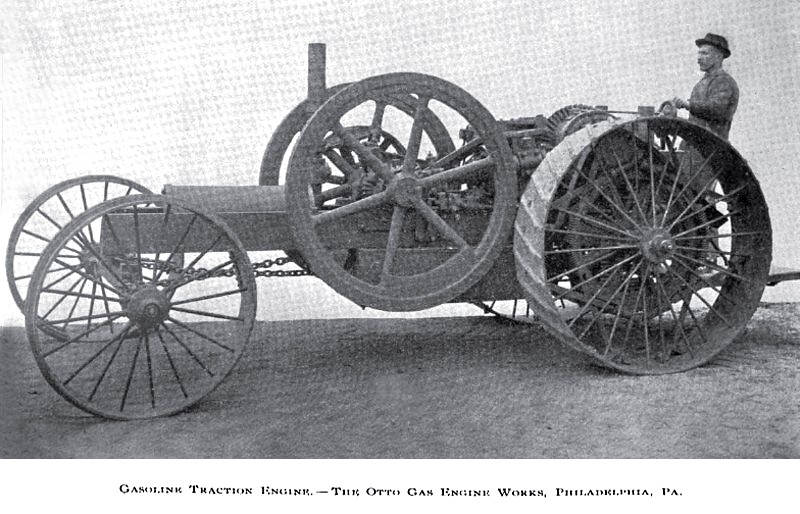|
Title: |
1895 Article-Otto Gas Engine Works, Gasoline Traction Engine |
|
Source: |
Industry Magazine, Oct 1895, pg. 596 |
|
Insert Date: |
12/13/2012 7:29:33 PM |
On the page opposite is seen a plate illustrating a traction engine that inferentially at least must have a good many advantages over a steam one of like power. The weight is less, and the details are not so many as are necessary in a steam traction engine. The driving wheels are five feet diameter, sixteen inches face, and are driven, as shown in the drawing by elastic tension rods and springs between the wheels and the main gear wheel. The tank immediately under the engine will contain seventy-five gallons of gasoline, a corresponding amount of cooling water, enough for a clay's work, is provided in the cylindrical tank forward. The whole scheme seems simple and complete.
Considering the circumstances under which traction engines are used, especially in farm work, it is remarkable that gasoline and oil engines have not been sooner and more widely employed for the motive power. The element of weight is necessary whatever power is used, but a steam boiler filled with water and a store of feed water and fuel exceeds the weight required for traction purposes when the wheels rest on the ground, besides the consumption of fuel and water by a steam engine causes great variation of the load, which is almost constant in the case of gas engines.
A traction engine is a very complicated kind of machine, expected to perform a wide range of duties that vary a great deal, in fact the design of such engines has remained for thirty to forty years past a most difficult problem for engineers and mechanics, so the slow adaptation and use of such engines is after all not strange.
We have recently passed over a road made with a traction engine, on the side of Clear Lake, California, in the mountains, forty miles from a railway, and there in that out-of-the-way place learned some things not known where machinery is more common and supposedly better understood. We were informed that the traction engine had torn up the chaparrel, raked off the ground, ploughed, scraped and ditched the highway, without the aid of horses, which is a very remarkable matter. We went to see the engine, and found it busy at work driving a sawmill, "having a rest" the owner of it said.
This engine has been up there in the mountains several years, three or more, busy all the time doing something in a place where of all others one would think traction engines could not be used. The owner of the engine is a "genius,'' at least that is the term by which his abilities are described in the neighborhood.
Another strange case, and a parallel one, is the use of traction engines in the Sierra Nevada Mountains, in this State, and in Nevada, where hauling of all kinds is done with them. We remember some years ago of seeing quite a train of wagons crawling after one of these queer-looking machines, bringing freight into Truckee.
In the valley, where the country is level, and the amount of freight per mile ten times as much as exists in the mountains, there seems to have been no more if as much success in traction hauling, but on the whole, power traction here in California has not been a failure, and some advance in the engines should spread rapidly their use all over the country.
For agricultural purposes, or at least for ploughing, there is not much promise of success. The land is not suitable. A friend of Mr. John Fowler, the greatest maker of steam traction engines in the world, said he once heard Mr. Fowler say that in California the land had two conditions: "Mortar in winter, and cement in summer." This is to some extent true of adobe land, but of no other. Fuel and water are impediments on the wide plains, but on common roads there are no difficulties here in the way of traction engines that do not exist elsewhere in the same degree. |
|
 1895 Otto Gas Engine Works, Gasoline Traction Engine
1895 Otto Gas Engine Works, Gasoline Traction Engine
|
|